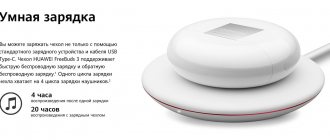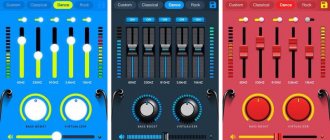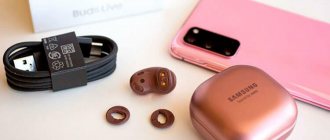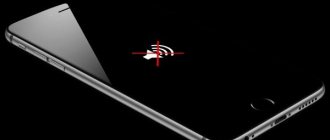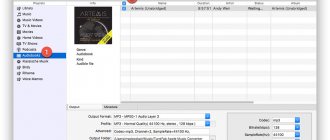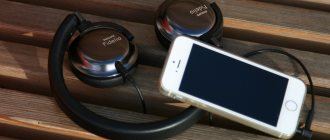Almost all gadgets - phones, tablets, players, laptops - have headphone outputs, they work and provide sound. However, it is interesting that with different amplifiers the output results in a completely different sound at the same volume on the same headphones. So what's the trick? A separate amplifier increases detail, changes the atmosphere of the sound, ensures maximum compliance with the source, and minimizes distortion.
Why do you need a headphone amplifier?
Replacing headphones may not always meet expectations for sound quality, but connecting an amplification device invariably guarantees a decent result.
The amplifier receives the audio signal from the source and amplifies its current and voltage to the required level of the headphones to obtain high-quality playback.
Hi-Res Audio
Modern smartphones are capable of supporting a similar standard, and Hi-Res is moving from a narrow segment niche into the big picture.
The sound quality is higher frequency than CD. The Hi-Res format is characterized by a sampling frequency from 96 to 192 kHz, with a frequency of 24 bits. For CD sound the parameters are 16 bits and 44.1 kHz.
The sampling rate is the number of times a signal is sampled per second in order to convert it into a “digital” signal from an analog state.
Advantages of Hi-Res Audio:
- high level of sound quality;
- Availability of sites for downloading in low bitrate compression formats.
Disadvantages of Hi-Res Audio:
- large file size, which makes transmission via Wi-Fi or mobile network difficult;
- there are restrictions on compatibility of Hi-Res audio formats.
DAC
The digital-to-analog converter is an element of the source-DAC-headphones circuit to increase sound quality. In headphones and speakers, sound reproduction is carried out using an analog signal. Audio CDs and the hard drive store files in digital format.
From which it follows that in order to obtain sound in headphones, digital-to-analog conversion must occur. The built-in DAC chip is an integral part of the amplifiers.
Balanced output
A balanced audio connection uses a balanced line connection type. The area of use was initially at concert venues and recording studios, as it provides the advantage of connecting through long cables that do not allow external interference to pass through.
With a balanced connection, a “phase-antiphase-ground” circuit is used, which allows you to “subtract” interference while maintaining the signal.
Increase the volume in headphones on your phone
Let's consider a situation in which the sound in the headphones is not loud enough for comfortable listening to music or using the phone. The most convenient way to increase the volume is to use various special applications. This method can be considered universal.
Changing the sound in the Volume Booster Plus app
Volume Booster Plus phone app
- Download the application using Google Play or similar services.
- When the application turns on, you will see a display of the capabilities of this application. Click “Next” several times to get to work.
- Click on the "Boost" button.
The program will automatically increase the sound volume on your device and display the resulting result as a percentage.
Amplifier selection criteria
Size
The dimensions of the device indicate its power, which depends on the output voltage, maximum output power and resistance.
Full-size headphones can hardly be adequately boosted by a small-sized amplification device. The ratio of the sensitivity of the headphones to the final volume level determines their output:
- from 1 to 2 V;
- 5 V.
The internal resistance of the headphones must correspond to the parameters of the amplifier, otherwise the output stage will be overloaded and distortion, both nonlinear and linear, will increase.
Amplifier classes
In total, there are three classes of amplifying devices:
- A;
- IN;
- AB.
“A” - amplification devices of the best quality and value, without distortion and maximum linearity. The negative side of the class is overheating and low efficiency. In the final stage the quiescent current is several amperes. “B” - devices operate at half-cycle, half of the wave is “quenched”, but the efficiency is more than 50%. “AB” is an intermediate class between the two above; a characteristic feature is the reduction of distortion by shifting at the beginning of the signal. The maximum value of the quiescent current is up to 150 mA.
Type
The entire numerous range of headphone amplification devices are divided into 2 types:
- stationary;
- portable - to improve the quality of playback via a phone, without purchasing a separate device - a player.
No. 2. DFX Audio Enhancer
The most popular digital audio format is MP3. Despite the fact that software manufacturers have been trying for a long time to make other, better formats popular, everything is useless. It is quite difficult to change established traditions that have been formed over decades. Therefore, the developers created a special utility, DFX Audio Enhancer, which could improve the advantages and hide the disadvantages of the popular format, as well as a number of other formats. The program allows you not only to increase the sound level, but also to increase the depth, as well as the range of higher frequencies and much more.
How to choose the right one
Almost all models have semiconductor circuitry, but there are also tube devices. The main task is to combine existing headphones with the purchased amplifier, or set the task of purchasing both devices at the same time. Headphones can be high-impedance - from 100 Ohms, and low-impedance, not every power can be achieved by a “weak” model. The good sensitivity of high-impedance headphones does not directly affect the volume level.
Price
Manufacturers occupy certain price niches; the following price groups can be distinguished:
- up to 10,000 rubles;
- up to 15,000 rubles;
- several tens of thousands of rubles.
It is difficult to decide which brand of device is better; the price ranges for both portable and stationary devices vary greatly.
Functional
Amplifiers with a built-in DAC have expanded functionality, this applies to:
- various sound sources;
- combination with other devices;
- the ability to adjust the level of “bass” for metal lovers and fans of hard rock;
- the presence of several inputs and outputs.
Playback quality
Sound is assessed according to the following basic parameters:
- detailing;
- stage depth and width;
- low, medium and high frequencies;
- noise level;
- purity;
- degree of proximity to the source.
Design and build quality
Famous brands try to adhere to a certain line of style and design. The desire for lightness and mobility of models remains in demand; bulky systems have sunk into oblivion.
For stationary devices, the priority is strength and reliability; for portable devices, size and thickness come first with the possibility of a “sandwich” configuration.
Volume
When comparing several amplifying devices by volume, they use voltage parameters that are measured by dBV; it is the difference in voltage numbers that indicates the volume delta in dB.
Errors in selection
The main erroneous calculations include:
- incorrectly selected device power;
- their mutual inconsistency;
- lack of necessary inputs, outputs and cords, connections in the package;
- insufficient functionality;
- weak battery:
- sound quality.
Top 5 – stationary headphone amplifiers
Listening to music with good headphones is a pleasure. And today there are no problems with connecting them, because the corresponding output is available in many devices, from AV receivers to laptops. So why do sophisticated audiophiles prefer dedicated amplifiers?
Because they provide not only an enviable volume reserve, but also sound quality unattainable for integrated amplification circuits.
An external solution can be found, for example, in the form of
battery-powered
module a digital-to-analog converter
. But there are classic amplifiers, completely analog and without any accompanying electronics. They are created for those who already have a high-quality source (and not necessarily digital), and the sound quality required is such that any portable options simply will not pass the selection. It is such devices that we will talk about. What are they good for? Firstly, the reserve of undistorted power. Yes, even mobile amplifiers of a decent level (from 10,000 rubles) can satisfy most owners of “complex” headphones. But there will always be that part of listeners who want extraordinary dynamics, even higher volume. Secondly, stationary amplifiers have good sound quality. No matter how talented the developers are, it is difficult to fit a high-quality amplifier stage into half the volume of a matchbox (the rest of the space in portable models is taken up by the battery). Designers of home models literally have more room for maneuver, there are no problems with heat dissipation, and power supply eliminates the need to think about the energy efficiency of the device in order to increase its battery life.
How much power do you need?
As you know, the reserve does not stretch your pocket. The more powerful the amplifier, the less restrictions and more pleasure you will have when listening to acoustic music on headphones, even with high impedance and low sensitivity. We recommend focusing on a value of at least 100 mW per channel when loaded with the impedance of your headphones. For example, if their specification specifies an impedance of 150 ohms, then a suitable amplifier should deliver as much as 100 mW per channel into a 150 ohm load without pushing the distortion level above 0.01%. Well, with an “honest” output power of 200 mW per channel at the required load, you are guaranteed not to have a volume deficit.
Tube or transistor?
The presence of models with a tube stage in the headphone amplifier segment is by no means a rare phenomenon. This is not surprising: many music lovers are sure that the “lamp” softens the sound of digital sources, making it more comfortable, more analog. In some cases, this is true when we are talking about high-end products. Simpler models often only imitate the pseudo-analog nature of sound by creating a roll-off in the HF region, reducing detail and smoothing out dynamic peaks. But in any case, a tube amplifier is a priori more sensitive to operating conditions, is more dependent on regular maintenance, and requires careful handling and time to reach operating mode. A transistor device does not cause such problems. As you may have guessed, our voice of reason is on the side of the “transistor,” but no one is stopping you from listening to all the options and choosing the one that suits you.
How much to pay?
Hi-Fi and High End equipment are akin to objects of art: there is no clear relationship between quality and price. More precisely, in conventionally mass-produced headphone amplifiers (up to 100,000 rubles), some relationship can still be traced, but in high-end models they can ask for a decent premium only for a prestigious brand, natural veneer finishing and the legend that the soldering of the printed circuit board is carried out using silver from candlesticks of the 14th century, and only on the full moon. Of course, such a device will sound decent in any case, but it is not at all a fact that the price tag will reliably reflect its sound potential. Therefore, choosing a headphone amplifier based only on price, design and brand is a reckless decision. You need to listen to all the options available to you, preferably blindly, so that the appearance and nameplate do not put psychological pressure on you. And then it may turn out that a completely ordinary amplifier for 20-30 thousand rubles with your headphones and your favorite music provides the same wonderful result as a model three times more expensive. Or it may be the other way around: your headphones will only “play” with a very expensive amplifier. And then there are two options: fork out the cash if you fall in love unconditionally, or look for more “accommodating” headphones.
Useful things
So what else should you pay attention to when buying?
For switching. If your source has an honest balanced output, and it is free, then it makes sense to pair the amplifier with the source precisely by “balance”. Although this does not guarantee unconditional superiority over conventional communication via an unbalanced cable with RCA connectors, the chances of success are high. The second is the number of inputs. This is important if you have several signal sources. Also pay attention to the number of outputs for connecting headphones (a useful option for those who like to arrange paired listening, or use two pairs of headphones for different tasks) and a line output for connecting an amplifier in the gap between the source and the pre-amplifier for the speakers. Well, the ergonomic volume control and remote control will make listening more comfortable. The prices indicated in the article are approximate as of August 2020.
Price – 11,000 rubles.
Pro-Ject is known primarily as a manufacturer of vinyl turntables. However, its catalog also includes other equipment, including headphone amplifiers. The Head-Box SE II model is the youngest, but no less interesting. The device in a steel case is powered by an external unit (it is supplied in the kit). On the facade there is only a volume control, a mechanical power switch, and a 6.3 mm output. On the rear panel you can find an input on RCA connectors and an output of the same format. The Head-Box SE II cannot be used as a preamplifier, but it can be connected “in the gap” immediately after the source to avoid the influence of the preamplifier or switch circuits on the sound, because any such nuances are much more noticeable in headphones. The output power of the device (330 mV at 30 Ohms and 60 mW at 300 Ohms) allows us to recommend it for working with headphones with impedance up to 150-200 Ohms. Listening confirms that under such a load, the Pro-Ject Head Box SE II copes with any recordings. And it also sounds very nice! Despite the all-transistor circuitry, the device’s playback character is “warm” and comfortable. Fans of acoustic music rich in overtones and silver-plated cables will surely like this device. The only nuance is the uncertain handling of dynamic bursts at high volumes: the peaks are slightly smoothed out, depriving the listener of sharpness and bite. We can assume that there is a lack of power from the power supply. Fortunately, it is external here. And this is another plus for the device, since experiments with nutrition often give very noticeable results.
Pros:
An excellent inexpensive headphone amplifier with an impedance of up to 150-200 Ohms, the ability to connect in the gap between the source and the preamplifier.
Minuses:
energetic music with biting dynamic bursts is handled somewhat phlegmatically.
Conclusion
An excellent inexpensive headphone amplifier with an impedance of up to 150-200 Ohms.
Connoisseurs of calm and richly nuanced music will certainly appreciate the large-scale and comfortable sound of the device. Fans of hard rock, metal and dynamic “synthetics” may find the device not energetic enough. Price – 15,000 rubles.
If it seems to you that the brand name resembles a Russian surname, then you are not mistaken! The HA-5 amplifier is a development of the company of Konstantin Musatov, based in the capital MTUSI on the street. Aircraft engine. The device is also produced in Russia. The lack of pathos (a modest website, a mobile phone as the main means of communication), piece production and a simple-looking body can be confusing. However, Musatoff products have been on the market for several years: back in 2012, we talked about high-end acoustic systems by Konstantin. The HA-5 amplifier is a basic-level product, but everything you need in terms of functionality is there: a high-quality analog potentiometer, a 6.3 mm output with adjustable gain, and a power switch on the front. The stated output is 200 mW at a load of 240 Ohms and 460 mW at 34 Ohms. The amplifier is based on “professional” Texas Instruments NE5532 operational amplifiers. The device sounds very neutral, yet dense and detailed. There is no lack of dynamics and power when using any headphones with a resistance of up to 250-300 Ohms. If the case were more solid, and with a more famous logo, the price tag would probably be higher. However, we cannot call this product a “Russian miracle” either. This is just a good-quality headphone amplifier - with a modest exterior and without any additional functions, but with decent sound and a reasonable price.
Pros:
attractive price/sound quality ratio, no lack of power when using headphones with impedance up to 300 ohms.
Minuses:
simple appearance, no through RCA output, the device can only be purchased from one company or directly on the manufacturer’s website.
Conclusion
Musatoff HA-5 is a device for those who do not need status, design or additional functionality, but simply an amplifier for working with one source and one pair of headphones.
The device copes well with models with resistance up to 300 Ohms. If we talk about sound quality, then even the “ears” of the Sennheiser HD700 level when connected to the Musatoff HA-5 demonstrate a significant increase in quality. A very good purchase, it’s a pity that there are only two ways to purchase it. Price – 45,000 rubles.
A solid-looking and very carefully made case, together with an “expensive” volume control, would have done honor to a more status device. Without the cover, the Soloist SL MKII looks even more luxurious, like a tuned supercar with the hood up. And there is something to be proud of: there is a toroidal power transformer with an effective filtering circuit, an ALPS volume control, Elna Silmic II capacitors, and Dale resistors. And a beautiful, neat installation! The manufacturer pays special attention to the purity of food and the selection of components. The stated output power supplied to the single 6.3mm output is 2,500 mW (!) per channel. True, with a load of 16 Ohms. The manufacturer does not provide data on recoil with a load of other resistance, but it is easy to guess that the Soloist SL MKII has more than enough power even for 600-ohm headphones. The level of harmonic distortion when delivering 1,000 mW into a 30 ohm load is 0.03%. On the facade of the device you can find LED indicators and two buttons. The lower one switches the gain, and the upper one switches the input. Yes, the Burson Audio Soloist SL MKII has two stereo inputs, but not a single output. This won't pose a problem if the source has a second output or headphones are your only means of audio playback. In other cases, it is better to think about the correct switching of the system in advance. However, the company's range includes a full-fledged preamplifier with a Conductor V2 headphone amplifier, which will solve this problem. When listening to the Burson Audio Soloist SL MKII, two things surprise me. Firstly, huge output power, and, as a result, very precise and controlled bass. Secondly, rhythm. It’s as if all the instruments were quantized in tempo, as a result of which the music acquired a special stability. The tonal balance of the device can be called neutral. The only complaint I can make is that the sound stage is insufficiently holographic. But overall, the Burson Audio Soloist SL MKII is very, very good.
Pros:
impressive output power, chic appearance, rhythmic and solid sound, two inputs.
Minuses:
There is no possibility of through-connecting a device between the source and the preamplifier.
Conclusion
For its class, the device looks simply gorgeous, and the sound has several very attractive qualities.
If the device had a linear output, and the sound stage was a little more accurate, it could well be on the second line of the rating. Price – 79,000 rub.
Despite the large selection of headphone amplifiers costing over one hundred and even two hundred thousand rubles and having very impressive sound and stunning appearance, we decided to put a model from a professional equipment manufacturer in second place in the rating this year. According to the author of this article, who has worked in the industry for over 17 years, incredibly expensive headphone amplifiers are no longer about sound, but about status and appearance. Who wants to powerfully wave a credit card - good for you, but there are not many headphones in the world that (with the support of appropriate signal sources and recordings) can justify at least part of the exorbitant price of the device. A model with first-class sound does not have to have a price tag of over a hundred, and the Lehmann Audio Linear is an excellent illustration of this fact. Granted, it looks like a 28 cm long brick, but the circuitry is five-star: a precision toroidal transformer in the built-in power supply, an ALPS potentiometer, a well-designed amplifier stage with an output of 200 mW at a load of 300 Ohms and 400 mW at 60 Ohms. For ease of use, there are three levels of amplification, activated by toggle switches on the bottom wall of the case. This makes it possible to use almost the entire range of the volume control with any headphones. The rear panel has not only a stereo RCA input, but also the same output. As long as headphones are not connected to the device, it passes the signal through. After connecting the headphones, the output is de-energized, which is convenient if you also have speaker systems in your home system. Lehmann Audio Linear sounds fantastically detailed, very dynamic and rich. This sound can be safely called studio in the good sense of the word. The device is suitable for use with dynamic headphones of any class.
Pros:
sound that is excellent in accuracy and detail, an impressive reserve of undistorted volume with headphones up to 600 Ohms, and a proven design.
Minuses:
there is no balanced switching, the mechanical power switch is located inconveniently (on the rear panel), a very ascetic appearance for such a price.
Conclusion
Even though the appearance of the device is simple, and its power switch is located extremely inconveniently, the Lehmann Audio Linear captivates with its fantastic purity and authenticity of sound.
It does not color or interpret the sound, but acts only as an intermediary, amplifying the signal with maximum accuracy and allowing the headphones to reveal themselves to their fullest. From our point of view, this is what an ideal headphone amplifier should be. I wish I could add more external solidity... However, this is not a problem! If you're willing to pay for spot-on improvements in sound and more expensive finishes, then go for the Lehmann Audio Linear SE model. Just remember that the price difference with the basic Lehmann Audio Linear is almost twofold. Price – 70,000 rubles.
Very often it turns out that a great-sounding preamplifier from the outside looks like something between a “homemade” product and a pre-production sample in a temporary case. But if a music lover pays a lot of money for such a product, then his frustration is understandable. From this point of view, the Beyerdynamic A 2 is strikingly different from most of its competitors. Its appearance was so successful that it was awarded the Red Dot Award in 2014. However, from a constructive point of view, the device is no less interesting. Let's start with the fact that this is one of the few amplifiers capable of driving 600-ohm headphones without any reservations, because even with such a load it produces a completely sufficient 100 mW per channel. With 250 Ohm headphones, the output power is 170 mW (and with a harmonic distortion level of only 0.001%). The multi-voltage power supply is built into the housing. The rear panel allows for installation of the included headphone storage support, and there are also two RCA inputs and one output. The front panel has two 6.3 mm format outputs and input selection buttons. They, like the volume, can be controlled remotely using a wireless remote control. What else can you dream about! As for the sound, Beyerdynamic A 2 is the bearer of its signature style - biting, sometimes even harsh, but large-scale, clean and with excellent bass. Even though we liked the Lehmann Audio Linear a little more in terms of sound character and quality, this subtle sound advantage is not the same as the Beyerdynamic A 2.
Pros:
reliable operation even with 600-ohm headphones, very decent sound, first-class appearance, thoughtful ergonomics, rich equipment (two inputs, two headphone outputs, remote control), headphone holder included.
Minuses:
no serious ones were identified.
Conclusion
We put Beyerdynamic A 2 on the first line of the rating not because it sounds brilliant.
In this sense, it is no better than Lehmann Audio Linear, and in some ways it is even inferior. However, if that device is a functional product, then this one is a complete product for the end consumer: it not only adequately fulfills its direct duties, but also gives aesthetic pleasure and provides maximum ease of use. At the same time, it is also slightly cheaper than Lehman. Denis Repin
Editorial staff of Hi-Fi.ru
The best headphone amplifiers
Portable models
FiiO
The company entered the global market in 2007 and won the trust of customers, primarily with its headphone amplifier product line. The ideal price-quality ratio has become decisive in taking a leading position. The company regularly releases new products and is characterized by rapid growth in consumer demand segments. The innovative ideas of the developers are based on the gained production experience. The priority areas remain quality, ergonomics, creativity, and practicality. One of the brand's latest breakthroughs was a fourfold increase in production capacity. The company has also strengthened its quality control and testing of finished products.
FiiO Q1 Mark II
A stereo amplifier from China with a power of 0.112 W, with a built-in battery, is a high-resolution gadget.
| FiiO Q1 Mark II | |
| Channels, number | 2 |
| Front channel. Power, W | 0,112/0,075 |
| Playback frequencies 3.5 outputs. Range, Hz | 5:55000 |
| Balanced output playback frequencies. Range, Hz | 6:80000 |
| DAC | AK 4452 |
| Battery, built-in, mAh | 1800 |
| Full charge, t, h | 4 |
| T (time) of operation on one charge, hour | 10 |
FiiO Q1 Mark II
Advantages:
- excellent detailing;
- decent bass boost without loss;
- compactness;
- balanced output with a jack diameter of 2.5 mm;
- linear output, excluding DAC, in “amplifier” mode;
- no interference from the volume control;
- high build quality typical of FiiO;
- The kit includes rings for fastening;
- provides an increase in the volume of the stage;
- when simultaneously switching the bass and volume amplifiers, the headphones are pumped to the maximum;
- good clarity and assertiveness of sound;
- the level of low frequencies does not prevail against the general background;
- the presence of two LED regulators;
- optimal price-quality ratio;
- the ability to create a “sandwich” with an amplifier and a smartphone on ties included and a silicone gasket with existing cords;
- good battery charge;
- a noticeable increase in sound with an amplifier in relation to the “own” sound of the smartphone;
- possibility of purchasing on Aliexpress;
- supports all resolutions up to 384 kHz-32 bit, DSD256;
- keeping the price at the level of the first generation Q1;
- the presence of a sticker and a scratch strip on the packaging to control originality;
- The kit includes a Lightning cable for iOS devices;
- stylish “refined” design with gold inserts – a “roll call” to Grundig.
Flaws:
- quick discharge of the smartphone when connecting headphones through it and Wi-Fi to the computer;
- without Android USB cable;
- without volume control protection in “sandwich” placement.
Which amplifier is better to buy for headphones?
Most models today come with built-in DACs, which additionally affect the sound. And some of them can also serve as an adapter, allowing you to connect Bluetooth headphones to any supported sources.
Amplifiers may differ from each other in appearance, chip responsible for sound processing, and supported codecs.
When choosing an amplifier, it is important to pay attention to the voltage and what impedance the headphones support. If the indicators do not match, the sound will either be too quiet or of poor quality.
It is also worth paying attention to whether the amplifier has a built-in battery, or whether it will be powered by a smartphone. In the second case, the main gadget will discharge twice as fast.
The types of inputs must match the ports of the planned sound sources: smartphone, tablet or laptop.
Finally, don't ignore the dimensions and weight. This is still an additional piece of plastic and metal that you will have to carry with you.
Recommendations: 10 Best Headphone Adapters
10 Best Preamps
11 best amplifiers
Best Premium Portable Amplifiers
This is a truly advanced, but still compact technique for true music lovers.
McIntosh MA50
5
★★★★★
editorial assessment
100%
buyers recommend this product
The stylish amplifier has a DAC that supports quality up to 32 bit/192 kHz. As a source, you can use both smartphones running iOS or Android, as well as computers running Windows or macOS. Wireless connection with Bluetooth 4.1 and aptX is also supported.
MA50 operates up to 5 hours on a single charge. Due to the support of several power modes, the amplifier can easily “make friends” with a wide variety of headphones with impedance from 8 to 600 Ohms.
It also uses the manufacturer's proprietary technology called Headphone Crossfeed Director (HXD), which creates a sound effect similar to the sound from stereo speakers.
Advantages:
- Stylish design;
- Combination of amplifier and DAC;
- Support for different sources;
- Ability to work with any headphone impedance;
- Rich scope of supply;
- Good autonomy.
Flaws:
- Price from $700.
An almost standard portable amplifier with a DAC that will make even the coolest headphones sound even better. Alas, the device cannot be called compact, and in terms of price it has a lot of competitors.
It is worth using appropriate headphones with such a device - models for $100-200 will not create the required effect.
Periodic Audio Nickel
5
★★★★★
editorial assessment
97%
buyers recommend this product
This amplifier stands out from full-size analogues by the absence of a volume control, the function of which is transferred to the sound source, for example, a smartphone.
There is a built-in battery that is charged via USB and lasts approximately 8 hours. There is an indicator on the case to indicate the charge status. The device itself is quite small.
Nickel works with headphones with a resistance of up to 50 Ohms and produces standard 20-20,000 Hz. A USB-microUSB cable is used for connection. The amplifier sounds powerful and provides sound with good bass.
Advantages:
- Compact and lightweight;
- Convenient charge indicator;
- Good autonomy;
- Beautiful sound with pronounced low frequencies.
Flaws:
- Price.
A good compact amplifier that provides a sound that can be described in one word - powerful.
CEntrance DACportable SP
4.9
★★★★★
editorial assessment
90%
buyers recommend this product
Quite a large amplifier, for which the increased dimensions open up new opportunities that are not available to compact models.
It is worth noting that carrying it in your pocket with a smartphone can be inconvenient. But the sound with this amplifier becomes more detailed and noticeable bass appears.
To connect the source there is only a microUSB connector, so you may need an adapter. There is a built-in battery, so the DACportable SP will not drain your smartphone.
Advantages:
- Great sound with improved bass;
- Good autonomy and independence from a smartphone;
- Volume control.
Flaws:
- One microUSB connector and one wire included;
- Angular design.
A good amplifier designed to improve the quality of music, regardless of the source. However, it is not suitable for those who value design - the device in this regard is clearly inferior to other top models.
Beyerdynamic Impacto Universal
4.8
★★★★★
editorial assessment
87%
buyers recommend this product
This is an amplifier without adapter functions that only works with individual headphones from the same manufacturer.
But perhaps over time a separate, more universal version will be released that will already support all models. Impacto works with headphones from 32 to 600 ohms and decodes audio up to 32-bit/384 kHz.
Despite its dimensions, the box weighs only 12 grams. However, when used with an iPhone, you will need an additional battery, which is attached directly to the case. In the case of Android, the amplifier will be powered through a connector directly from the smartphone.
Advantages:
- Easy;
- Nice design;
- Support for modern smartphones;
- High-quality sound;
- There is an additional battery.
Flaws:
- Compatible only with selected headphone models.
In operating mode, this amplifier looks more like a regular control panel, typical for wired headphones, than a separate device. Of course, we are not talking about versatility here, but the amplifier improves the sound - as much as possible.
READ ALSO
12 best sound cards

